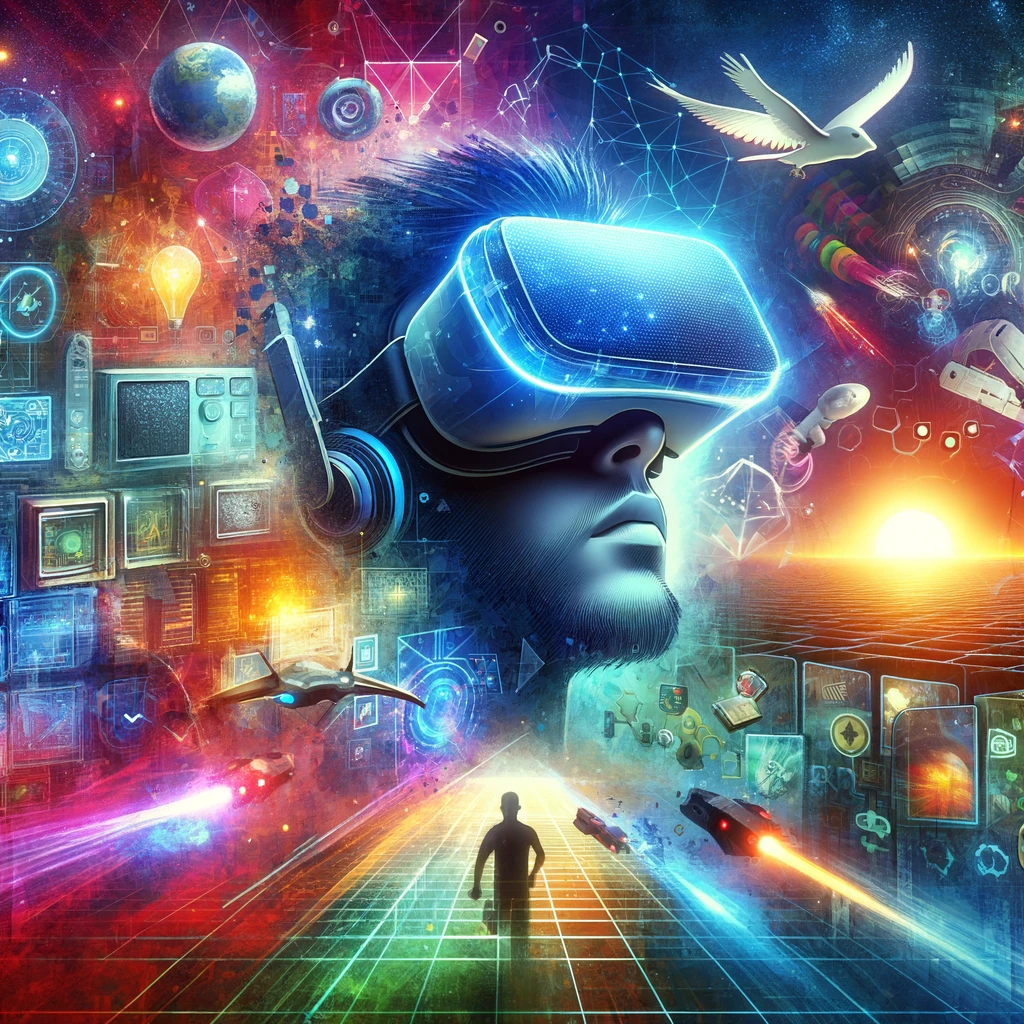The landscape of gaming is undergoing a seismic shift, propelled by the advent of Virtual Reality (VR) and Augmented Reality (AR) technologies. Once the domain of sci-fi novels, VR and AR are now reshaping the way we interact with digital content, offering immersive experiences that blur the line between the virtual and the real. In this blog post, we delve deep into how these technologies are transforming the gaming industry, backed by real data and insights.
The Rise of VR Gaming: A Dive into a New Dimension
Virtual Reality has transcended its nascent stage to become a mainstay in the gaming world. The VR gaming market size, valued at USD 11.8 billion in 2019, is expected to expand at a compound annual growth rate (CAGR) of 30.2% from 2020 to 2027, according to a report by Grand View Research. This growth is fueled by advancements in VR hardware, like the Oculus Rift and HTC Vive, which offer high-fidelity, immersive experiences.
Games like “Half-Life: Alyx” have set new standards for VR gaming, offering a level of interactivity and immersion that was previously unattainable. The game’s success, selling over 2 million copies in 2020 alone, underlines the growing appetite for high-quality VR experiences.
Augmented Reality: Blending the Real and the Virtual
Augmented Reality takes a different approach, overlaying digital information onto the real world. Games like Pokémon GO and Harry Potter: Wizards Unite have popularized AR, showcasing its potential to create engaging, location-based experiences. According to a report by Statista, the AR gaming market is projected to reach a value of over 285 billion U.S. dollars by 2023.
AR’s ability to bring gaming into the real world presents unique opportunities for social interaction and physical activity, a stark contrast to traditional gaming’s sedentary nature. This aspect of AR gaming has significant implications for game design and player engagement.
The Future of Gaming: Trends and Predictions
- Increased Accessibility and Adoption: As VR and AR technologies become more affordable and widespread, we can expect to see a surge in their adoption. This democratization will not only enhance the gaming experience but also broaden the scope of potential applications.
- Social and Multiplayer Experiences: VR and AR are poised to revolutionize multiplayer experiences, offering new ways for players to interact and collaborate. We anticipate games that leverage these technologies to create deeply social and engaging experiences.
- Integration with Other Technologies: The convergence of VR and AR with other technologies like AI, cloud computing, and 5G will unlock new possibilities in gaming. This integration can lead to more personalized and seamless experiences.
- Health and Fitness Applications: With games like Beat Saber and VR fitness apps, VR is proving to be a viable tool for physical exercise. AR, too, with its ability to integrate with the real world, presents exciting opportunities in this realm.
Navigating the Challenges: VR and AR in Gaming
While VR and AR have opened new frontiers in gaming, they also present unique challenges that must be addressed to realize their full potential.
Technical Limitations and Accessibility
One of the primary hurdles in VR gaming is the need for high-end hardware. The cost and space requirements for a full VR setup can be prohibitive for many gamers. Similarly, AR games, while more accessible, often require the latest smartphones to function optimally. As technology advances, we anticipate a reduction in these barriers, making VR and AR gaming more accessible to a broader audience.
Health and Safety Concerns
VR and AR also raise concerns regarding player health and safety. Issues like motion sickness in VR and the physical risks of AR gaming in outdoor environments are areas that require ongoing research and innovative solutions. Game developers and hardware manufacturers are continuously working on improving the ergonomic design and user safety features of their products.
Content Creation and Quality
The complexity of creating high-quality VR and AR content cannot be understated. These platforms demand a different approach to game design, prioritizing immersive environments and intuitive interactions. The future success of VR and AR in gaming hinges on the development of compelling content that can attract and retain users.
Leveraging VR and AR for Educational and Training Purposes
Beyond entertainment, VR and AR hold tremendous potential in education and professional training. These technologies offer immersive, interactive experiences that can enhance learning and skill development. For instance, VR simulations for medical training or AR applications in mechanical repairs are already showing promising results, providing hands-on experience in a controlled, risk-free environment.
Conclusion: The Future is Immersive
The journey from pixels to reality through VR and AR technologies is not just a gaming revolution; it’s a paradigm shift in how we interact with digital content. As we continue to push the boundaries of what’s possible, these technologies will increasingly become integral parts of our daily lives, transcending gaming to impact education, training, and beyond.
Explore our range of game platform services to experience the future of gaming today. Join our community, follow us on social media, and stay updated with the latest trends and innovations in immersive gaming. Your engagement and feedback drive us forward, and we look forward to hearing from you in the comments section below. Let’s shape the future of gaming together, transforming pixels into reality.
FAQs
Q1: What are the Key Differences Between VR and AR in Gaming?
Answer: Virtual Reality (VR) immerses the user in a completely virtual environment, typically using a headset that covers the eyes and ears. In contrast, Augmented Reality (AR) overlays virtual elements onto the real world, often through a smartphone or AR glasses. While VR offers a more immersive and isolated experience, AR integrates digital elements with the user’s environment, creating a blend of reality and virtuality.
Q2: How Do VR and AR Affect the Gaming Experience?
Answer: VR and AR transform gaming from a passive, screen-based activity into an interactive, immersive experience. VR games can offer total immersion, making the player feel like they are truly inside the game world. AR games add a layer of interactivity to the real world, allowing players to engage with their environment in novel ways. Both technologies significantly enhance player engagement and offer new forms of storytelling and gameplay.
Q3: What are the Hardware Requirements for VR and AR Gaming?
Answer: VR gaming typically requires a VR headset, such as the Oculus Quest, HTC Vive, or PlayStation VR, and a compatible gaming system or PC with sufficient processing power. AR gaming, on the other hand, is more accessible and often only requires a smartphone or tablet with AR capabilities. However, specialized AR headsets, like the Microsoft HoloLens, offer more advanced features.
Q4: Are There Health Risks Associated with VR and AR Gaming?
Answer: While VR and AR gaming are generally safe, they can cause discomfort in some users. VR can lead to motion sickness, eye strain, or disorientation, especially during prolonged use. AR gaming, particularly when played outdoors, can pose physical safety risks if players are not aware of their surroundings. It is important to follow safety guidelines, take regular breaks, and use these technologies responsibly.
Q5: Can VR and AR Be Used for Purposes Beyond Gaming?
Answer: Absolutely. VR and AR have applications in various fields beyond gaming, including education, training, healthcare, and design. For instance, VR is used for immersive training simulations in medicine and the military, while AR can aid in complex tasks like machinery maintenance or surgical procedures by overlaying helpful information onto the real world.
Q6: What Does the Future Hold for VR and AR in Gaming?
Answer: The future of VR and AR in gaming is poised for significant growth, with advancements in technology making these experiences more realistic and accessible. We can expect more sophisticated and diverse content, better hardware, and deeper integration with other technologies like artificial intelligence and 5G networks. These advancements will lead to more immersive, interactive, and socially connected gaming experiences.
Q7: How Can Developers Overcome the Challenges of Creating VR and AR Content?Answer: Developers can overcome these challenges by focusing on user-centric design, investing in research and development, and collaborating across disciplines. Emphasizing intuitive interfaces, engaging storytelling, and comfortable experiences can make VR and AR content more appealing. Additionally, leveraging community feedback and staying updated with technological advancements are crucial for creating successful VR and AR games.



